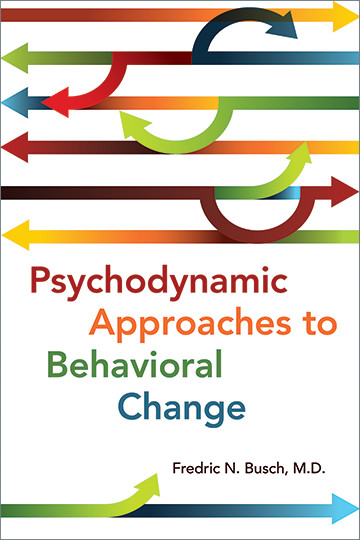The title of the book Psychodynamic Approaches to Behavioral Change is not something you usually hear in the same sentence in the psychotherapy world. Therapists tend to identify as either psychoanalytically or psychodynamically oriented, or more behaviorally inclined (e.g., practicing cognitive-behavioral therapy). Busch’s book is a noble attempt to dispel some of the historical taboos on psychoanalytic technique. His book suggests that not only does targeting behavioral change not disrupt the psychoanalytic process, but it can often aid in the exploration and gaining of insight. According to Busch, learning to target behavioral change in addition to the more classical psychoanalytic approach expands “the therapist’s armamentarium for helping patients to obtain insight, relieve distress and improve relationships” (p. 10).
Busch discusses some of the reasons why psychoanalysts have historically avoided incorporating behavioral change–type interventions into the therapeutic process. He offers a through and thoughtful list of concerns that might be raised by psychoanalysts as to why targeting behavioral change can be problematic, such as creating dependency on the therapist; having patients become conflicted about a therapist’s suggestions; pleasing or, the opposite, rebellious responses toward to the therapist; and hindering with transference and countertransference. Busch does a nice job addressing and challenging each of these points while still holding to a psychodynamic approach that addresses fantasies, intrapsychic conflicts, defense mechanisms, and object relations.
One of the main strengths of this book, although not explicitly stated, is teaching how to constantly link past and present for the patient. Winnicott stated that one of the aspects of transference is the way in which we must allow the patient’s past to be the present. What distinguishes the therapeutic relationship from any other relationship is that the therapist and patient are given the space to analyze and explore how the past is played out in the present through transference with the therapist and in outside relationships. The book shows, in a very practical, down-to-earth manner, how the therapist can help “put a stick in the wheel” of the patient’s habitual patterns, learned over time. Linking the past and present allows for interventions that resonate more with the patient and that avoid abstractly analyzing the past, without a clear connection as to how it is played out in current situations. Interventions that address only the past, without a clear link to present manifestations, often require the patient to remember distant events and emotions that she or he has more difficulty accessing or identifying with as an adult. This is a skill the book does a wonderful job of illustrating and teaching.
The book is intended to appeal to a “broad range of mental health professionals who use a variety of treatment approaches” (p. ix) and is written in a practical, straightforward manner with many case illustrations. Although it is a welcome approach to make the book as accessible as possible to a large audience, this comes at the expense of in-depth theory. The book seems appropriate for therapists taking their first steps in psychodynamic approaches who need practical advice on how to construct interventions.
The author chooses to focus mainly on case illustrations that address what he refers to as a “common type of behavioral problem”—that of inhibitions in assertiveness, “which can be found in many syndromes, including anxious and depressive disorders, as well as cluster C personality disorders” (p. 13). His working definition of inhibitions in assertiveness is “the capacity to directly and appropriately express one’s feelings, beliefs, and opinions to another person” (p. 13). Although the author claims this type of problem can be found in many syndromes, many of the case illustrations seem to roughly equate to what McWilliams refers to as depressive personality disorder (
1). Thus, the illustrations feel like they are too often limited to a particular type of patient, and frequently the solution offered is too simplistic. However, for therapists treating patients with a depressive disposition, this book can be a true gold mine as to how to promote behavioral change (i.e., greater assertiveness and communication) in this type of personality.


